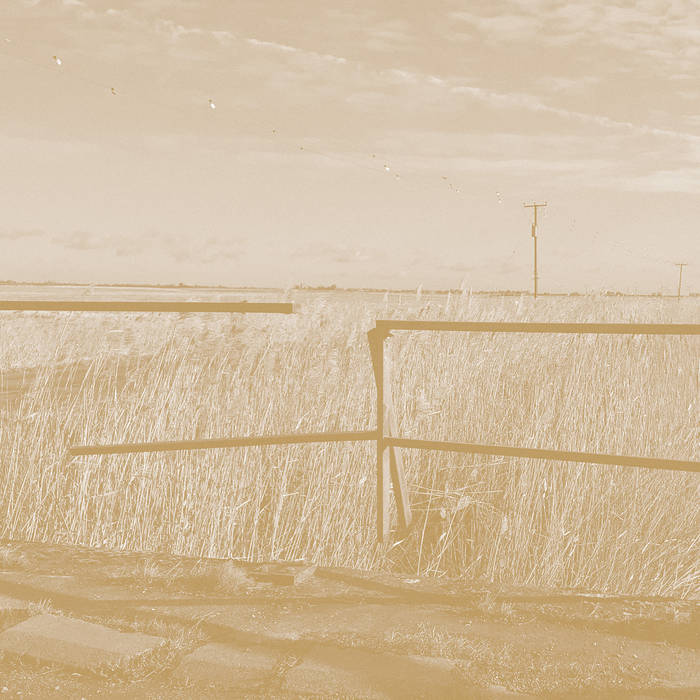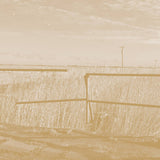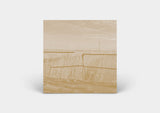Simon Scott // Long Drove CD
- Availability:
British ambient writer Simon Scott (Slowdive drummer) released his latest work in December 2022 on the Australian experimental label Room12.
Includes 6 ambient songs that are as soft as the winter sunshine.Shrink specifications.
Below is a commentary by the label and writer.
The title of the first edition Scott wrote for Room40, 'Long Drove' is about the Fens, a place near home for British composer, multi-instrumentalist and mastering engineer Simon Scott.It's a connecting walkway between two nature reserves called Holmfen and New Decoy, both of which are part of a habitat restoration project called the Great Fen Project, and are close to where Scott grew up as a child.The region first served as a place for Scott's compositional inspiration over a decade ago when he produced 'Below Sea Level' on 2k (later re-released on Touch).Back in the Fens, he produced several new productions, intimate sonic tales of place and rural trauma presented in this Long Drove.
The Fens' near future remains a glaring concern, with further subsidence and the threat of flooding.Field recordings are extinguished and unfolded by a melancholic wash of decaying tape loops and digitally processed Fenland sound textures, so that, as a result of climate change, they return to their original wetlands, and once submerged again the fences You can almost hear Scott's thought process about what it might sound like in these five songs.
“I regularly visit a remote and unnamed broken bridge over a long drainage ditch connecting Holmfen and the New Decoy Nature Reserve, just to listen. As the seasons change, I return to watch the cries of wildlife merge and coalesce with the sound of long electrical wires strung across wide, flat fences. I sensed the character of the sound and immediately began recording in its vast polyphonic glory, when by chance my water bottle hit an iron bridge and a gong echoed across the fence landscape. Secondly, I decided to use soft mallets to actually play the bridge as a percussive instrument to capture its resonance, then set up a small DPA mic in one of the bridge's vertical openings to simulate the metal bridge. I wanted it to act as a filter for many of the sound waves inside and outside the bridge, and depending on what part of the bridge you hit and what season you hit it, the bridge would have a different vibratory sound quality. .
Holme Fen Posts makes looped recordings taken from one of the two posts of the famous steel Holme Fen Nature Reserve, the lowest map point in England (6 feet above mean sea level). It's traced.The post was driven into the ground in 2 by William Wells, a local landowner, to obtain measurements of land subsidence.The pillars were fitted with metal placards showing the date of subsequent ground subsidence, and Scott sandwiched two contact microphones between horizontal pillars to capture the sound waves.The recorded sounds reveal not only the slow, deep vibrating sounds of the iron sculptures, but also natural phenomena, such as the downpour that occurred when Scott recorded, and the rhythmic dynamics produced by the surrounding resonances.
The natural phenomenon of the wind becomes the hallmark of the Aeolian sound heard on The Whistling Wire, and the soft rhythm of the tapping of bridges becomes the long drones and reverberant qualities that their vibrations create, giving rise to the intricate fens sounds. It represents the terrain of sound.Capturing the symphonic glory of wind igniting wire holes without human intervention.This is what triggers the transmissible musical transitions induced by climate change. The Black Fen is manipulated by tracing a sound field through cassette tape loops of Aeolian field recordings and fed into Scott's modular synth system, gradually bringing out hidden melodies.
Labels and other worksplease use this form. ///Click here to see more Room40 releases available at Tobira.
----------------------------
Matte laminate, monochromatic printed and embossed sleeve + insert card.
Room40:
"'Long Drove', the title of Scott's first edition for Room40, is a location in the Fens close to the home of British composer, multi-instrumentalist and mastering engineer Simon Scott. It is the connective pathway between two nature reserves, called Holme Fen and New Decoy, and both sites are part of a habit restoration project called The Great Fen Project and is close to where Scott grew up as a child. This area first became a location of compositional inspiration over a decade ago, when Scott created 'Below Sea Level' on 12k (later reissued on Touch). His return to the Fens has produced a number of new works, presented here on 'Long Drove', that are intimate sonic narratives of place and rural trauma.
'Long Drove' is a site-specific sound study which shifts the Anthropocene discourse from spectatorship to musical participation, accountability, and creative engagement. The near future of the Fens, with concerns of further subsidence and threat of flooding, remains a palpable concern. One can almost hear Scott's thought processes within these five compositions, of what the Fens would sound like if submerged and flooded by water again, returning to its original marshland state as a result of climate change, as the field Recordings dissipate and unfurl with melancholic washes of decaying tape loops and digitally processed textures of Fenland sonorities.
“I regularly visit the remote and nameless broken bridge,” Simon explains, “that is situated over a long drainage ditch that connects Holme Fen and New Decoy nature reserves, simply to listen. Each season I'd return to observe the sonorities of wildlife merge and coalesce with the hum of the long telephone wires that stretch across the wide and flat Fens. Within my audition I'd perceive different sonic characteristics within the same location and I soon began to record its vast polyphonic glory. By pure serendipity my water bottle accidentally struck the steel bridge, and it rang out like a gong across the Fen landscape. This inspired me to use soft mallet beaters to actually play the bridge as a percussive musical instrument and capture its resonant qualities. A subsequent desire was also to place my tiny DPA microphones inside one of the bridge vertical openings to act as a filter of the many sonorities within and outside of the metal bridge. ge would differ depending on what part of the bridge I struck and what season it was.”
'Holme Fen Posts' traces out looped recordings taken from one of two of the famous steel Holme Fen nature reserve posts, which are located at the lowest cartographical location in England (six feet below mean sea level). in 1851 to take ground readings of subsidence by local landowner William Wells. Metal placards were attached to the posts to depict the subsequent dates of the level of the ground and Scott wedged two contact microphones in between the horizontal posts to capture its sonorities. reveal not only the slow and deep vibratory sounds of the steel sculptures but also the rhythmic dynamics created by natural phenomena, such as the downpour occurring as Scott recorded, and the resonances within the surrounding area.
The natural phenomena of wind became aeolian sound characteristics, as heard in The Whistling Wire, and the soft rhythm of the bridge being struck became the long-pitched drones and reverberant textures that these vibrations produced reveals the complex sonic topography of the Fens. the symphonic glory of the wind which, without any human intervention, ignites the holes in the wires. This triggers shifting planes of transmissible climate change induced musicality. 'The Black Fen' traces sound fields through cassette tape loops of aeolian field recordings which are manipulated when fed into Scott's modular synth system to gradually tease out submerged hidden melodies.
Artist: Simon Scott
Label: Room40
British ambient writer Simon Scott (Slowdive drummer) released his latest work in December 2022 on the Australian experimental label Room12.
Includes 6 ambient songs that are as soft as the winter sunshine.Shrink specifications.
Below is a commentary by the label and writer.
The title of the first edition Scott wrote for Room40, 'Long Drove' is about the Fens, a place near home for British composer, multi-instrumentalist and mastering engineer Simon Scott.It's a connecting walkway between two nature reserves called Holmfen and New Decoy, both of which are part of a habitat restoration project called the Great Fen Project, and are close to where Scott grew up as a child.The region first served as a place for Scott's compositional inspiration over a decade ago when he produced 'Below Sea Level' on 2k (later re-released on Touch).Back in the Fens, he produced several new productions, intimate sonic tales of place and rural trauma presented in this Long Drove.
The Fens' near future remains a glaring concern, with further subsidence and the threat of flooding.Field recordings are extinguished and unfolded by a melancholic wash of decaying tape loops and digitally processed Fenland sound textures, so that, as a result of climate change, they return to their original wetlands, and once submerged again the fences You can almost hear Scott's thought process about what it might sound like in these five songs.
“I regularly visit a remote and unnamed broken bridge over a long drainage ditch connecting Holmfen and the New Decoy Nature Reserve, just to listen. As the seasons change, I return to watch the cries of wildlife merge and coalesce with the sound of long electrical wires strung across wide, flat fences. I sensed the character of the sound and immediately began recording in its vast polyphonic glory, when by chance my water bottle hit an iron bridge and a gong echoed across the fence landscape. Secondly, I decided to use soft mallets to actually play the bridge as a percussive instrument to capture its resonance, then set up a small DPA mic in one of the bridge's vertical openings to simulate the metal bridge. I wanted it to act as a filter for many of the sound waves inside and outside the bridge, and depending on what part of the bridge you hit and what season you hit it, the bridge would have a different vibratory sound quality. .
Holme Fen Posts makes looped recordings taken from one of the two posts of the famous steel Holme Fen Nature Reserve, the lowest map point in England (6 feet above mean sea level). It's traced.The post was driven into the ground in 2 by William Wells, a local landowner, to obtain measurements of land subsidence.The pillars were fitted with metal placards showing the date of subsequent ground subsidence, and Scott sandwiched two contact microphones between horizontal pillars to capture the sound waves.The recorded sounds reveal not only the slow, deep vibrating sounds of the iron sculptures, but also natural phenomena, such as the downpour that occurred when Scott recorded, and the rhythmic dynamics produced by the surrounding resonances.
The natural phenomenon of the wind becomes the hallmark of the Aeolian sound heard on The Whistling Wire, and the soft rhythm of the tapping of bridges becomes the long drones and reverberant qualities that their vibrations create, giving rise to the intricate fens sounds. It represents the terrain of sound.Capturing the symphonic glory of wind igniting wire holes without human intervention.This is what triggers the transmissible musical transitions induced by climate change. The Black Fen is manipulated by tracing a sound field through cassette tape loops of Aeolian field recordings and fed into Scott's modular synth system, gradually bringing out hidden melodies.
Labels and other worksplease use this form. ///Click here to see more Room40 releases available at Tobira.
----------------------------
Matte laminate, monochromatic printed and embossed sleeve + insert card.
Room40:
"'Long Drove', the title of Scott's first edition for Room40, is a location in the Fens close to the home of British composer, multi-instrumentalist and mastering engineer Simon Scott. It is the connective pathway between two nature reserves, called Holme Fen and New Decoy, and both sites are part of a habit restoration project called The Great Fen Project and is close to where Scott grew up as a child. This area first became a location of compositional inspiration over a decade ago, when Scott created 'Below Sea Level' on 12k (later reissued on Touch). His return to the Fens has produced a number of new works, presented here on 'Long Drove', that are intimate sonic narratives of place and rural trauma.
'Long Drove' is a site-specific sound study which shifts the Anthropocene discourse from spectatorship to musical participation, accountability, and creative engagement. The near future of the Fens, with concerns of further subsidence and threat of flooding, remains a palpable concern. One can almost hear Scott's thought processes within these five compositions, of what the Fens would sound like if submerged and flooded by water again, returning to its original marshland state as a result of climate change, as the field Recordings dissipate and unfurl with melancholic washes of decaying tape loops and digitally processed textures of Fenland sonorities.
“I regularly visit the remote and nameless broken bridge,” Simon explains, “that is situated over a long drainage ditch that connects Holme Fen and New Decoy nature reserves, simply to listen. Each season I'd return to observe the sonorities of wildlife merge and coalesce with the hum of the long telephone wires that stretch across the wide and flat Fens. Within my audition I'd perceive different sonic characteristics within the same location and I soon began to record its vast polyphonic glory. By pure serendipity my water bottle accidentally struck the steel bridge, and it rang out like a gong across the Fen landscape. This inspired me to use soft mallet beaters to actually play the bridge as a percussive musical instrument and capture its resonant qualities. A subsequent desire was also to place my tiny DPA microphones inside one of the bridge vertical openings to act as a filter of the many sonorities within and outside of the metal bridge. ge would differ depending on what part of the bridge I struck and what season it was.”
'Holme Fen Posts' traces out looped recordings taken from one of two of the famous steel Holme Fen nature reserve posts, which are located at the lowest cartographical location in England (six feet below mean sea level). in 1851 to take ground readings of subsidence by local landowner William Wells. Metal placards were attached to the posts to depict the subsequent dates of the level of the ground and Scott wedged two contact microphones in between the horizontal posts to capture its sonorities. reveal not only the slow and deep vibratory sounds of the steel sculptures but also the rhythmic dynamics created by natural phenomena, such as the downpour occurring as Scott recorded, and the resonances within the surrounding area.
The natural phenomena of wind became aeolian sound characteristics, as heard in The Whistling Wire, and the soft rhythm of the bridge being struck became the long-pitched drones and reverberant textures that these vibrations produced reveals the complex sonic topography of the Fens. the symphonic glory of the wind which, without any human intervention, ignites the holes in the wires. This triggers shifting planes of transmissible climate change induced musicality. 'The Black Fen' traces sound fields through cassette tape loops of aeolian field recordings which are manipulated when fed into Scott's modular synth system to gradually tease out submerged hidden melodies.
Artist: Simon Scott
Label: Room40




![Natalie Beridze // Of Which One Knows LP [BLACK / COLOR]](https://tobirarecords.com/cdn/shop/files/on1_7feae78a-8719-45ce-80d4-fd2e81136a92_medium.jpg?v=1701421535)
![Beatriz Ferreyra // UFO Forest + LP [COLOR / BLACK]](https://tobirarecords.com/cdn/shop/files/ufo1_medium.jpg?v=1699408652)
![Eugene Carchesio + Adam Betts // Circle Drum Music LP [COLOR / BLACK]](https://tobirarecords.com/cdn/shop/files/eu1_621880fd-e908-423f-89ac-d73c971908e3_medium.jpg?v=1699408462)
